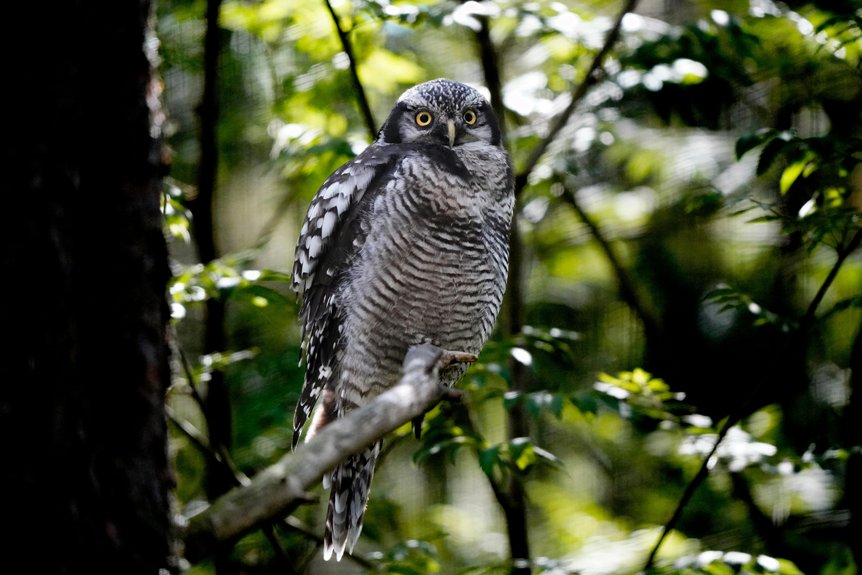For prime owl spotting near Paphos, focus on diverse habitats like the Akamas Peninsula forest edges, where dusk reveals Cyprus Scops Owls balancing dense woods and open spaces. Mavrokolympos Dam’s quiet shrubland with accessible dirt roads offers serene nocturnal views. Near Tala village, mixed pine forests and scrublands provide excellent spots to hear owl calls at dawn or dusk. Stavros Psokas combines pine woods with a river corridor, ideal for nesting and prey availability. Kouris Valley’s mature woodlands offer rich foraging and nesting zones. Explore more details to refine your owl-watching strategy.
Key Takeaways
- The Akamas Peninsula forest edges, especially near Avakas Gorge, offer excellent dusk and night owl spotting with a focus on the endemic Cyprus Scops Owl.
- Mavrokolympos Dam’s combination of water and forest edges with quiet dirt roads supports nocturnal owl activity and visibility.
- Paphos Forest trails near Tala Village provide mixed pine and cedar habitats ideal for Cyprus Scops Owl nesting and evening call listening.
- Stavros Psokas area’s dense Calabrian pine woods and river corridor create prime cavity-nesting sites and attract diverse prey for owls.
- Kouris Valley woodlands’ mature pine and broadleaf mix offer natural cavities and quiet conditions favorable for spotting and hearing owls.
Akamas Peninsula Forest Edges
Although the Akamas Peninsula is primarily known for its rugged landscape and biodiversity, its forest edges offer prime opportunities for owl spotting, especially during dusk and night hours. When exploring the Akamas forest edges, you can encounter the Cyprus Scops Owl, a distinctive species prevalent in this area. These forest margins create an ideal habitat, balancing dense woodland cover and open spaces, which attract owls hunting smaller prey. For effective paphos forest owl spotting locations Cyprus, focus on quieter paths near Avakas Gorge and coastal woodlands where owls are known to be active. The cooler autumn and winter months enhance your chances, as some migratory birds settle here and nocturnal activity increases. By moving quietly and using a flashlight with a red filter to avoid disturbance, you can observe these elusive birds better. Given the peninsula’s status as a protected area under Natura 2000, preserving the natural environment also guarantees owl populations thrive in these forest edge zones.
Mavrokolympos Dam Vicinity
The area surrounding Mavrokolympos Dam offers some of the best opportunities for spotting the Cyprus Scops Owl, particularly at dusk when these owls become active. This relatively quiet reservoir, set about 11 kilometres from Paphos, combines a serene aquatic environment with nearby forest edges that serve as ideal owl habitats. You’ll find that the dam’s modest size and the bordering shrubland facilitate unobstructed views and reduce human disturbance, increasing your chances of seeing nocturnal activity. The adjacent dirt roads, though uneven, provide access to various vantage points.
| Feature | Detail |
|---|---|
| Location | Paphos District, Cyprus |
| Access | Via Coral Bay road, 11 km from Paphos |
| Habitat Type | Reservoir with surrounding forest and shrubland |
Paphos Forest Trails Near Tala Village
Paphos Forest Trails near Tala Village provide an excellent habitat for the Cyprus Scops Owl, with forest edges and rural surroundings that these owls prefer for breeding and foraging. When you explore these trails, you’ll find a mix of pine forests, open scrublands, and quiet paths that create ideal conditions for spotting owls. The village of Tala sits close to well-maintained walking routes, including those starting near the Agios Neophytos monastery, where you can encounter diverse birdlife amid ancient forests. The trails feature varied terrain, from gentle uphill climbs to flatter stretches, offering vantage points to listen for owl calls during dusk or dawn. The combination of cedar and pine trees provides suitable nesting sites, while the low human disturbance helps maintain a peaceful environment. For the best experience, focus on the shaded woodland edges and avoid noisy areas to increase your chances of observing Cyprus Scops Owls actively hunting or calling in their natural habitat.
Stavros Psokas River Area
Stavros Psokas River Area offers a prime location for spotting the Cyprus Scops Owl amid its diverse riparian and forest habitats. This area combines dense Calabrian pine woods with the moist river corridor, creating an ideal environment for this cavity-nesting owl. You’ll find natural tree cavities and even artificial nest boxes along the river, accommodating the species’ unique breeding needs, especially since local pines rarely form cavities on their own.
When exploring Stavros Psokas, focus on dusk and dawn hours when Cyprus Scops Owls are most vocal and active. The mix of forest edge and water-rich zones attracts a variety of prey, increasing your chance to observe owl hunting behavior. The river valley’s quiet trails and minimal light pollution further enhance owl-watching opportunities, making this area a top recommendation for researchers and birdwatchers targeting this endemic species on Cyprus.
Kouris Valley Woodlands
Though quieter than riverine spots, Kouris Valley Woodlands offer a well-structured habitat for the Cyprus Scops Owl, combining mature Calabrian pine stands and mixed broadleaf patches. This creates an ideal environment for nesting, as the owl prefers natural cavities typically found in older trees. The mixed woodland facilitates rich invertebrate prey availability, supporting the owl’s dietary needs year-round.
When exploring Kouris Valley for owls, pay close attention to areas where Calabrian pines and broadleaves intermingle, as these are prime nesting zones. Unlike the more active Stavros Psokas River Area, Kouris Valley’s serenity offers less disturbance, increasing your chances of hearing the owl’s distinctive two-note call.
| Feature | Benefit for Cyprus Scops Owl |
|---|---|
| Mature Calabrian Pines | Provide essential nesting cavities |
| Mixed Broadleaf Patches | Support diverse invertebrate prey |
| Quiet Woodland Habitat | Reduces disturbance, aids detection |
| Elevation Variation | Expands suitable nesting sites |
This balance of habitat features makes Kouris Valley Woodlands a key location for targeted owl spotting in Paphos Forest.
Frequently Asked Questions
What Time of Year Is Best for Spotting Cyprus Scops Owls?
The best time to spot Cyprus scops owls is during their breeding season, which runs from April through August, with egg-laying starting in late April to early July. During this period, they are more active and vocal, especially near their cavity nests in trees or buildings, increasing your chances of spotting them. Outside these months, they tend to be more silent and less visible.
Are Cyprus Scops Owls Active During the Day or Night?
You might picture a silent bird at rest by day, then imagine it stirring into life as darkness falls. The Cyprus Scops Owl is primarily nocturnal, most active from sunset through midnight when it hunts insects and small prey. During daylight, it remains still and camouflaged on tree branches, occasionally calling but mostly quiet. Some studies even note limited daytime calling in specific conditions, but generally, this owl favors the night for activity and vocalization.
What Type of Calls Do Cyprus Scops Owls Make?
The Cyprus Scops Owl produces a distinctive territorial two-note whistling call, especially noted in early spring. This call is key to identifying the species and differs from the one-note whistle of the Eurasian Scops Owl. Males often emit this call repeatedly during the breeding season, sometimes “duetting” with females, creating characteristic paired whistles. The call’s clear, repetitive pattern is typically heard at night and signals the owl’s presence in its habitat.
Do Cyprus Scops Owls Nest in Urban Areas or Only Forests?
You might picture Cyprus scops owls strictly nesting deep in forests, but they actually adapt well to various habitats. They nest in natural tree cavities, including in olive and conifer trees, as well as in cavities in buildings and nest boxes near forest edges and rural areas. Significantly, they are often found in or near towns, gardens, farms, and even parks, showing they’re not limited to dense forests but do nest in urban and semi-urban environments too.
What Is the Typical Diet of the Cyprus Scops Owl?
You typically feed on insects, mainly Orthoptera (grasshoppers, crickets) and Coleoptera (beetles), which make up about 87% of your diet by abundance and 31% by biomass. You also consume small mammals, reptiles, earthworms, spiders, and occasionally small birds, but these form a much smaller part of your diet. You catch insects using your beak and seize larger prey with your talons from a perch.
Conclusion
In Cyprus’s wild heart, the forest edges and river valleys around Paphos serve as whispered gateways where owls weave their twilight stories. By tiptoeing through Akamas Peninsula’s fringes, tracing the Mavrokolympos Dam, or wandering near Tala and Stavros Psokas, you step into a domain alive with soft wings and watchful eyes. The Kouris Valley woodlands knit this tapestry tight, inviting you to decode the night’s silent poetry one hoot at a time, where nature’s clock beats slow and secrets fly free.

Meet Natalie, who has lived on Cyprus for the last 10 years. She loves exploring the beautiful nature of the island, like quiet forests and untouched beaches. Natalie has lots of cool experiences to share. Join her as she talks about her adventures in Cyprus.

